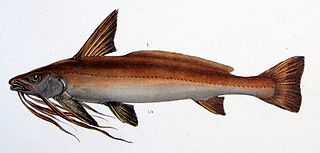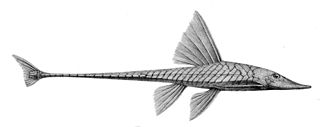Vandellia is a genus of catfishes native to South America. The species in this genus are the most well-known of the parasitic catfishes also known as candiru, known for their alleged habit of entering the human urethra.

Acanthicus is a genus of large, South American suckermouth armored catfishes native to the Amazon and Orinoco basins, and possibly in Guyana. The name Acanthicus is derived from the Greek, akanthikos meaning thorny, spiny. Fish of this genus are known as lyre-tail plecos. These species are found in large rivers, primarily in areas with a rocky bottom and a moderate or strong current.
Scoloplax is the only genus in the catfish family Scoloplacidae, the spiny dwarf catfishes.

Hemiancistrus is a genus of suckermouth armored catfishes. These species are native to South America. The taxonomy of this genus is complex and unclear, and major work has to be done. Many of these fish are popular aquarium fish.

Platysilurus is a genus of long-whiskered catfishes native to South America.

Pinirampus pirinampu is a species of catfish of the family Pimelodidae. P. pirinampu is also known as the flatwhiskered catfish.
Nannoptopoma is a small genus of catfishes of the family Loricariidae. This genus includes two species, N. spectabile and N. sternoptychum.

Sturisoma is a genus of armored catfishes native to Central and South America.
Haemomaster venezuelae is a species of catfish of the family Trichomycteridae, and the only species of the genus Haemomaster. This fish grows to about 6.6 centimetres (2.6 in) SL and originates from the Amazon and Orinoco River basins.
Tridensimilis is a genus of pencil catfishes native to South America.

Hemiodontichthys is a monotypic genus in the family Loricariidae, under the order Siluriformes, containing a single species, Hemiodontichthys acipenserinus, also known as the Pinocchio whiptail catfish, Pinocchio catfish, Pinocchio cat or the knob-nosed whiptail. This shy, bottom-dwelling catfish is native to the Guianas, Brazil, Bolivia and Perú in South America.
Tridentopsis is a genus of pencil catfishes native to South America.
Pseudostegophilus is a genus of pencil catfishes native to rivers in tropical South America. The members of this genus are obligate parasites that feed on scales and mucus of other fish.
Schultzichthys is a genus of pencil catfishes native to South America.
Stegophilus is a genus of pencil catfishes native to South America.
Pygidianops is a genus of pencil catfishes native to South America.
Typhlobelus is a genus of pencil catfishes native to South America.
Ochmacanthus is a genus of pencil catfishes native to South America. These species are distributed in South America. O. alternus and O. orinoco originate from the Rio Negro and Orinoco River basins of Brazil and Venezuela. O. batrachstoma inhabits the Paraguay River basin in Brazil. O. flabelliferus lives in river drainages in Guyana and Venezuela. O. reinhardtii is known from the Amazon River basin in Brazil and drainages in French Guiana.
The Stegophilinae are a subfamily of catfishes of the family Trichomycteridae. It includes 12 genera: Acanthopoma, Apomatoceros, Haemomaster, Henonemus, Homodiaetus, Megalocentor, Ochmacanthus, Parastegophilus, Pareiodon, Pseudostegophilus, Schultzichthys, and Stegophilus. A monophyletic group within the Stegophilinae is supported by two characteristics of the lateral line, including Acanthopoma, Henonemus, Megalocentor, Pareiodon, Parastegophilus, and Pseudostegophilus. Acanthopoma and Henonemus have a sister group relationship.
Pseudolithoxus is a genus of suckermouth armored catfishes with five described species from the basins of the Orinoco, Casiquiare and upper Rio Negro in Venezuela. Additionally, a possibly undescribed species is known from the Trombetas and Nhamundá rivers in Brazil.






